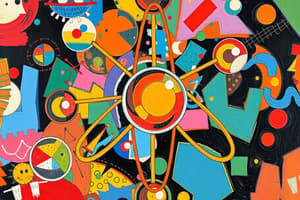Podcast
Questions and Answers
What particles are found in the nucleus of an atom?
What particles are found in the nucleus of an atom?
- Neutrons and electrons
- Protons and electrons
- Electrons and ions
- Protons and neutrons (correct)
Which statement about electrons is TRUE?
Which statement about electrons is TRUE?
- Electrons move in fixed positions around the nucleus.
- Electrons are negatively charged and occupy energy levels around the nucleus. (correct)
- Electrons are positively charged particles located in the nucleus.
- Electrons contribute to the atomic mass significantly.
How do isotopes of an element differ from each other?
How do isotopes of an element differ from each other?
- They are always unstable.
- They have different atomic masses due to differing charges.
- They have different numbers of protons.
- They have different numbers of neutrons. (correct)
What represents a cation?
What represents a cation?
What primarily determines the atomic mass of an atom?
What primarily determines the atomic mass of an atom?
Flashcards are hidden until you start studying
Study Notes
Structure of Atom
-
Basic Definition:
- An atom is the smallest unit of matter that retains the properties of an element.
-
Components of Atom:
-
Protons:
- Positively charged particles.
- Found in the nucleus.
- Determines the atomic number and identity of the element.
-
Neutrons:
- Neutral particles with no charge.
- Also located in the nucleus.
- Contributes to the atomic mass and stability of the nucleus.
-
Electrons:
- Negatively charged particles.
- Move in energy levels (or shells) around the nucleus.
- Involved in chemical bonding and reactions.
-
-
Nucleus:
- Central part of the atom.
- Composed of protons and neutrons.
- Holds most of the atom's mass.
-
Electron Configuration:
- Electrons are arranged in energy levels around the nucleus.
- The arrangement determines the chemical properties and reactivity of the element.
- Common notation follows the order: 1s, 2s, 2p, 3s, etc.
-
Atomic Mass:
- The mass of an atom is primarily due to the mass of protons and neutrons.
- Measured in atomic mass units (amu).
-
Isotopes:
- Atoms of the same element with varying numbers of neutrons.
- Example: Carbon-12 and Carbon-14.
- Different isotopes may have different chemical properties and stability.
-
Ions:
- Atoms that have gained or lost electrons.
- Cations: Positively charged ions (loss of electrons).
- Anions: Negatively charged ions (gain of electrons).
-
Conclusion:
- Understanding the structure of the atom is fundamental to chemistry, as it explains the behavior of elements and compounds in chemical reactions.
Atom Structure
- The smallest unit of an element is an atom.
- Atoms consist of protons, neutrons, and electrons.
- Protons carry a positive charge, reside in the nucleus, and determine the element's atomic number.
- Neutrons are neutral particles located in the nucleus; they contribute to the atom's mass and nuclear stability.
- Negatively charged electrons travel in energy levels around the nucleus, dictating an element's chemical behavior and reactivity.
- The nucleus houses protons and neutrons, comprising the majority of an atom's mass.
- Electrons occupy specific energy levels, arranged in a configuration that dictates how an element will react chemically.
- The atomic mass, measured in atomic mass units (amu), is primarily determined by the combined mass of protons and neutrons.
- Isotopes are atoms of the same element that differ in their neutron count, impacting their chemical properties and stability.
- Ions are atoms that have gained or lost electrons. Cations are positively charged due to electron loss, while anions are negatively charged due to electron gain.
Studying That Suits You
Use AI to generate personalized quizzes and flashcards to suit your learning preferences.




